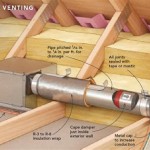How to Plumb a Basement Bathroom Without Breaking Concrete
Installing a bathroom in a basement can be a great way to add living space and increase the value of your home. However, plumbing a basement bathroom can be a daunting task, especially if you're dealing with a concrete floor. Breaking up concrete can be messy, time-consuming, and potentially damaging to the structure of your basement. Fortunately, there are several alternative methods for plumbing a basement bathroom without resorting to breaking concrete.
Planning and Preparation
Before you begin any plumbing work, it's essential to have a detailed plan in place. This includes determining the location of your bathroom fixtures, the type of plumbing materials you'll need, and the layout of your existing plumbing system. Consider the following factors:
- Location of existing plumbing lines: Identify the closest water supply lines and wastewater drain lines to your proposed bathroom location. This will help determine the shortest and most feasible routes for new plumbing connections.
- Accessibility of existing plumbing lines: Assess the ease of access to existing plumbing. If the lines are buried deep within the concrete floor, you may need to consider alternative methods like running new lines along the walls or ceiling.
- Code compliance: Check with your local building department to ensure your plumbing project meets all necessary codes and regulations. This may include requirements for vent pipes, trap seals, and water pressure.
Once you have a comprehensive plan in place, gather all the necessary tools and materials. You'll need:
- Plumbing fixtures: Toilet, sink, bathtub or shower, and any additional fixtures you require.
- Plumbing supplies: PVC pipes, copper pipes, fittings, valves, and adhesives.
- Tools: Pipe cutters, wrenches, soldering equipment (if using copper pipes), level, measuring tape, and safety gear.
Using Existing Plumbing Lines
If your basement already has existing water supply and wastewater drain lines, you may be able to connect your new bathroom fixtures without breaking concrete. This approach involves running new lines along the walls or ceiling to connect to the existing system. This can often be done without disturbing the concrete floor, but it may require some creative routing and installation techniques.
Example: If there's an existing drain line in the basement ceiling, you can run a new drain line from your bathroom sink down the wall and connect it to the existing line in the ceiling. This requires cutting into the wall, but it avoids breaking concrete.
Here are some considerations when using existing plumbing lines:
- Pipe accessibility: Ensure that the existing lines are accessible for connections. This may require removing drywall or other finishes.
- Pipe size: Verify that the existing pipes are large enough to accommodate the additional flow from your new bathroom fixtures. If not, you may need to install a larger pipe or a separate vent line.
- Vent requirements: Ensure your new plumbing lines comply with venting requirements, which typically involve connecting to a vent stack that extends above the roof.
Alternative Plumbing Techniques
If using existing plumbing lines isn't an option, you can consider these alternative methods to avoid breaking concrete:
1. Trenching
Trenching involves creating a narrow channel in the concrete floor to lay new plumbing lines. This technique can be used for both water supply and wastewater drain lines. It's less disruptive than breaking up the entire floor, but it still requires cutting into the concrete.
- Equipment: You'll need a concrete saw or a specialized trenching tool to cut the trench.
- Depth: The trench needs to be deep enough to accommodate the pipes and fittings, with enough room for backfilling and leveling.
- Sealing: Once the pipes are installed, the trench should be backfilled with concrete or a suitable sealant to prevent leaks and moisture infiltration.
2. Plumbing Through the Ceiling
In some cases, it may be possible to run plumbing lines through the basement ceiling. This approach involves cutting into the ceiling and running the pipes to the bathroom fixtures. It's a more complex option, but it avoids breaking concrete entirely.
- Accessibility: Ensure the ceiling is accessible and that there are no structural elements hindering the installation process.
- Support and Insulation: Provide adequate support for the pipes and consider insulation to minimize noise and temperature fluctuations.
- Vent Requirements: Be mindful of vent pipe placement and compliance with building codes.
3. Sleevings and Glands
Sleevings and glands offer a way to pass plumbing lines through concrete without disturbing the entire floor. A sleeve is inserted into a hole drilled through the concrete, and the pipe is passed through the sleeve. A gland seals the gap around the pipe to prevent leaks.
- Hole Size: The hole should be slightly larger than the pipe diameter to allow for a secure fit for the sleeve.
- Material: Sleeves and glands come in various materials like PVC, metal, or rubber. Choose a material suitable for your plumbing application.
- Installation: Ensure proper installation of the sleeve and gland to create a watertight seal.
Conclusion
Plumbing a basement bathroom without breaking concrete requires careful planning, creative solutions, and a thorough understanding of plumbing techniques. By considering the options outlined above, you can successfully install your basement bathroom while minimizing disruption and potential damage to your basement's structure.

How To Diy Bathroom In Basement Without Breaking Concrete

How To Diy Bathroom In Basement Without Breaking Concrete

How To Diy Bathroom In Basement Without Breaking Concrete

How To Diy Bathroom In Basement Without Breaking Concrete

How To Add A Bathroom In Basement Without Breaking Concrete

How To Diy Bathroom In Basement Without Breaking Concrete

How To Install A Shower In The Basement Without Breaking Concrete Upgradedhome Com
Basement Bathroom Use Shower Vent For Toilet Page 2 Diy Home Improvement Forum

Basement Bathroom Plumbing Planning For A Below Grade Lavatory

How To Install A New Bathroom On Concrete Slab Or In Basement
Related Posts







